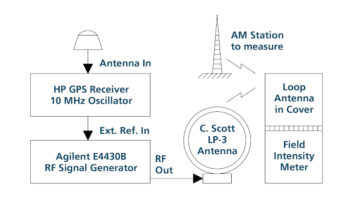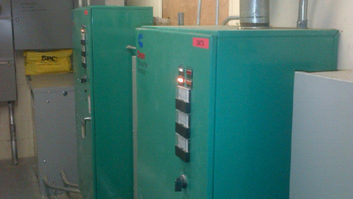(click thumbnail)An excellent reference book for maintaining tube-type transmitters is provided by Eimac. When buying equipment, I’ve always made it a practice to choose companies that make reference resources available to customers. Whether it’s training, white papers, applications notes or maintenance and troubleshooting supplements, these resources help expand our knowledge of a product, making us better engineers. As anyone who has tried to troubleshoot equipment with a blurry photocopied schematic knows, the least expensive is not always the best investment.
A number of years ago, I picked up what has become an engineering classic, Eimac’s “Care and Feeding of Power Grid Tubes.” This softcover book is chock-full of good information for anyone maintaining a tube-type transmitter.
In addition to discussing tube construction and operation, the section on cooling is especially useful. Because vacuum-tube education has long been abandoned by most college engineering curricula, or is at best an hour-long lecture in a semester-long course, finding good resource material about the workings of these important broadcast components is imperative.
Eimac’s update reflects tubes in common usage, and, for television engineers, an entire new section on inductive output tubes (IOTs) has been added.
Individual copies are available at no charge through Eimac’s worldwide distributor, Richardson Electronics. Requests should be made to Richardson at (800) 882-3872 or by e-mail at [email protected]
When you call, tell them you heard about the book from Radio World’s Workbench column.

. . .
Since we’re on the topic of tubes, have you ever had an FM transmitter that started dropping output power?
Winston Hawkins, technical director for the Baker Family stations, writes to us about a CCA FM 5000G transmitter that exhibited this condition.
Except for the transmitter power output, all parameters were as per the spec sheet. Winston twice replaced the IPA tube (3CX800A7) with a new tube, and tried three new (rebuilt) 3CX6000A7s. The TPO was supposed to be 4.7 kW and all he could get out of the rig was around 4.2.
(click thumbnail)When inspecting a transmitter, check every component carefully.
Curiously, if he increased the exciter power or rotated the power control, all he got was an IPA-ik that was on the peg, with just a small indicated increase in TPO. Winston uses the transmitter’s directional coupler/meter for forward/reflected power indications, as well as a Bird Watcher coupled to a separate line section. Both meters tracked.
Operating under the premise that two heads are better than one, Winston contacted Larry Schropp, a very capable contract engineer, to go over the transmitter with him. They painstakingly covered everything to be checked in the transmitter. During their thorough inspection, they discovered several large, wire-wound resistors that had cracked, as well as several connections in the high-voltage section that were not properly tightened. Although they discovered and corrected a number of small problems, they were disappointed to find that none improved the TPO.
Their search even extended to the output harmonic filter, so they placed a dummy load on the RF output of the transmitter through the Bird line section, and saw the same power level as before, 4.2 kW. To eliminate the Bird Wattmeter, they sent the line section, cables and meter panel back to Bird for calibration. Although the calibration ran around $350, they could not say if they had found anything wrong with the unit, another disappointment.
In the meantime, Winston had read somewhere of someone having a problem with a transmitter making full power with rebuilt tubes. The engineer chose a new Eimac tube and was able to get full power. Having exhausted his other options, Winston ordered a new Eimac 3CX6000 A7. With that installed in the transmitter, he was able, with no adjustments, to make full power immediately.
Winston’s experience is not a condemnation of rebuilt tubes; in many cases they work just fine. But if you experience trouble making full power using a rebuild, you may want to try a newly manufactured tube.
Winston Hawkins can be reached at [email protected].

. . .
Does your SBE chapter have a problem finding good programs for your monthly meetings? Finding a good program that’s interesting and informative can be a challenge, so here’s an idea: Contact Terry Baun of Criterion Broadcast Services.
Terry has developed a series of tutorials for broadcast engineers. Most recently, he delivered a session to the Ohio Broadcasters on the duties for a Designated Chief Operator as well as a review of FCC rules. More than 60 radio and television engineers registered. The course qualifies for SBE recertification credit, and certificates of completion are available.
Terry has developed a broad spectrum of course subjects. They include broadcast RF fundamentals for the non-engineer; broadcast engineering for broadcast managers, helping non-engineers understand the technical plant; management skills for the broadcast engineer; and broadcast networking fundamentals, which prepares the attendee for the SBE Broadcast Networking Technologist Certification Exam.
To help defray the cost of the sessions, most SBE chapters either combine forces with other chapters in the area, or work with their state broadcast association to co-sponsor the meeting. Terry has put together an informative brochure on his tutorials. You can request a copy from [email protected] or telephone (414) 559-5303.
. . .
Remember that dusty computer that’s been stuffed in a corner of the studio or under the console? It needs as much attention as any other component in the studio.
(click thumbnail)Fig. 1: This looks like the work of a dust bunny.
Radio World columnist Alan Peterson shares the picture in Fig. 1, a macro view of a hard-disk controller chip that has been removed from a drive on an audio workstation.
The chip has been zapped into oblivion. From what Alan could tell, a dust bunny got drawn into the PC by the fans, along with a fine strand of something that was conductive. It came to rest between this drive and the one below it and eventually grounded out, leaving the pitted scar you see on the chip package. Under magnification, it looks like a high-speed aviation impact with the ground.
Needless to say, up to 30 GB of important audio was lost on this drive. When something like this happens, it’s every man and woman for themselves. All the more reason to keep a good supply of canned air, dust brushes and a mini-vacuum in the shop. It’s astounding what 5 VDC can do, a good reminder that everything needs routine maintenance.
Submissions for this column are encouraged and qualify for SBE recertification credit.









